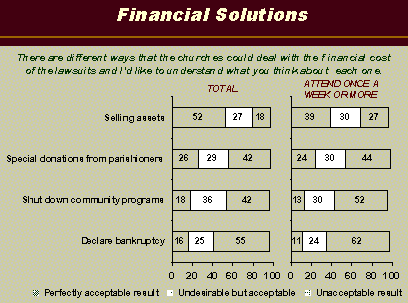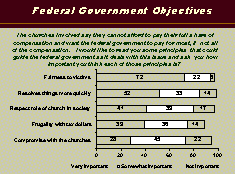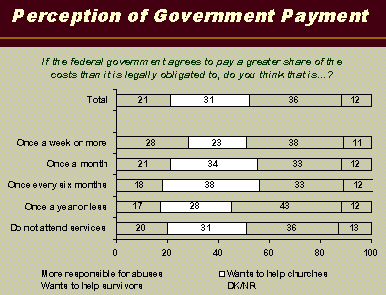

Summary of Key Findings
Synopsis
INTRODUCTION
![]()
 Earnscliffe Research and Communications is pleased to present this summary of polling results of a national quantitative survey conducted, in conjunction with Pollara Research, on the issue of residential schools.
Earnscliffe Research and Communications is pleased to present this summary of polling results of a national quantitative survey conducted, in conjunction with Pollara Research, on the issue of residential schools.
The findings are based on a national survey of 1512 randomly selected Canadians, 18 years of age or older conducted between March 6 and March 15, 2001. The sample included oversamples in each of the four western provinces and Atlantic Canada. As a result, the data has been weighted to 1125 to reflect census data on regional distribution. The margin of error for a sample of 1125 is +/-3.0, nineteen times out of twenty.
The following synopsis is in effect a summary, and as such, its intent is to offer analytical perspective for all questions on the survey.
SUMMARY
![]()
- This is a high profile issue with which most Canadians are familiar. It is also an issue that most Canadians are interested in, including coming to a resolution.
- Generally, most Canadians think there is some validity to many of the claims.
- By and large, most Canadians do not believe financial compensation is the only means to help the victims of the residential schools issue. Support groups and counseling are the preferred methods of helping victims of abuse, more so than financial compensation. However it is compelling as a symbol that the abuse was taken seriously.
- Virtually all, including frequent churchgoers, see government and churches as both legally and morally responsible, and as such, believe the ideal resolution would be a 50/50 share of responsibility.
- There is not a lot of sympathy for churches paying less than their full legal share. In fact, there is skepticism, less so among frequent churchgoers, that the claims threaten the churches' viability.
- Divesting assets is the most widely accepted option for how the churches could cope with financial demands. Bankruptcy was found to be unacceptable by a majority of Canadians.
- Canadians overwhelmingly believe that the national churches bear responsibility for the abuse by their constituent parts and should be responsible for compensation if the individual parts cannot meet their obligations.
- In evaluating how the government should proceed, most people say the government should be guided by ensuring fairness for victims.
AWARENESS AND INTEREST
One of the purposes of the survey was to assess the level of awareness among Canadians on the issue of residential schools.
Familiarity with the issue was tested in two fashions – unaided and aided. Of the two, aided familiarity (where respondents are read a brief description of the issue) is the more reliable measure. Unaided familiarity tests top of mind recall.
This is a high profile issue with which most Canadians are familiar. For instance for comparison, this issue received less attention than a federal budget, but more than a fall update.

With respect to the level of awareness before prompting (unaided familiarity), only 18% of Canadians polled were not at all familiar with the issue. This was much higher among people under the age of 30 where 27% were not at all familiar with the issue before hearing a brief description. Perhaps not surprisingly, people who attend religious services once a week or more were the most familiar with the issue.

Aided familiarity was 90% nationally, consisting of 34% who were very familiar and 56% who were somewhat familiar with the issue of residential schools. Regionally, people from western Canada are more familiar with the issue, while Quebecers tend to be quite a bit less engaged in this issue.

Evidence suggests that people are not only aware of the issue but are interested on a number of different levels. Canadians, particularly churchgoers, genuinely care about the outcome and resolution of this issue.

GENERAL ATTITUDES
Respondents were asked a series of questions to gauge their position on the claims, as well as on the long-term effects of abuse and how to best help its victims.
These questions were important in evaluating respondent's position on the issue and to get a sense of their preferred methods of compensation.
Almost all Canadians (85%) think there is validity to some of the claims. Forty-three (43%) believe almost all claims are true though somewhat more (48%) disagree. In fact, more people think that many of the claims are false than think almost all claims are true.
Anglicans, in particular, are less skeptical than other denominations as are people from British Columbia.

There is no question, however, that Canadians think that where the abuse occurred, it impacts on the victim for a lifetime. Respondents from Quebec and Atlantic Canada were particularly sympathetic.

HOW TO COMPENSATE
With respect to the methods of helping the victims of abuse in residential schools, we tested four methods: counseling, support groups, traditional approaches to healing, and financial compensation.
Support groups and counseling are seen to be the most effective responses to help victims of abuse. In both cases, 78% of Canadians feel this method of help is very important.

Financial compensation is seen to be the least important and is met with some resistance in western Canada.

Financial compensation is most compelling as a symbol – that the abuse was taken seriously or that someone has taken responsibility for it. Financial compensation is not seen as critical to helping people cope or to put the abuse behind them. However, many people accept that money can help people help themselves.

RESPONSIBILITY AND ACCOUNTABILITY
Virtually all see government and churches both legally and morally responsible for the abuse that occurred in residential schools. More people see the churches as having a moral responsibility than who believe that of the government. Churches and government are seen by an equal number of people to have legal responsibility. Frequent churchgoers are less likely to agree but most believe the church has both a legal and a moral responsibility in these cases.

Less than one in ten see the government as primarily responsible. Three times as many place primary responsibility with the churches.

In terms of churchgoers, Catholics are more likely than others to say that neither the church nor the government is responsible. People who attend religious services on a regular basis are also twice as likely to say government is primarily responsible. Sixty percent say the government is primarily or equally responsible.

The notion that both are equally to blame was mirrored in what most people believed to be an appropriate allocation of the financial burden. A 50/50 share is the most commonly cited division while 2/3 of respondents were within 60/40 either way.

PAYING COMPENSATION
Respondents were asked whether they supported financial compensation being paid by the government and the churches.
Survey results illustrate that most people support the government paying compensation where the abuse has been proven, and that even more people support the churches paying compensation.

Even among frequent churchgoers – those who attend religious services once a week or more – only one in four oppose the churches paying compensation.

Support for government payment dropped somewhat when the potential cost was added. The results below illustrate the difference when the question was asked with a two billion dollar cost tag and without.

Another important caveat is the demand that the claim be proven. Most people want the government to be vigilant about false claims. The belief that many of the claims are not true combined with skepticism about the usefulness of financial compensation means that support for compensation is quite conditional for some people.
THE FINANCIAL BURDEN ON CHURCHES
There is not a lot of sympathy for the churches paying less than their full legal share. Not many believe that the claims threaten the churches' viability. However, with the exception of the Catholic church, there is a fair bit of uncertainty about the financial impact. The Catholic church is seen as being in a different financial league from the other churches.


Frequent churchgoers, those who attend religious services once a week or more, see more financial threat from the process than others do, but as illustrated above, even most Catholics do not see it as a threat to the Catholic Church.

Of the options presented for how the churches could cope with the financial demands of these cases, only bankruptcy was found to be unacceptable by a majority of Canadians and even that is more acceptable than placing an undue burden on taxpayers. Most people are quite untroubled by the churches having to divest assets to meet their obligations. There is less support for closing down other church programming, presumably because people tend to believe those programs are doing something important. Even frequent churchgoers do not find divesting assets to be unacceptable.

In fact, evidence suggests that there will be significant opposition, even anger, if churches evade their share of responsibility and, as a result, taxpayers pick up shortfall. A major cleavage exists between churchgoers and the rest of Canadians.

National Church and Individual Churches
When it comes to the principle of national churches paying compensation if their individual parts cannot, the results are overwhelming. Almost three quarters of people say they should (71%), almost half feeling so strongly (41%). Strong opposition to that proposition is quite small (14%.) Even when the legal status of the churches is explained (providing a possible legal rationale for not paying), the same number (40%) strongly disagree that a national church should not have to pay compensation if one of its parts cannot afford to. Overall support levels for that position remain high – at close to two thirds.

Underlying that position is the clear majority sense that the churches as a whole bear responsibility for the incidence of abuse.
At least two thirds of Canadians think the entire church is responsible, not just the local parish/unit.

GOVERNMENT OBJECTIVES
The survey tested a number of principles that might guide the government if the churches were not able to pay their full share of compensation and the government were expected to pay the difference. The principle that found the broadest consensus for guiding government is fairness to victims. The only principle tested that found lukewarm support was "compromising with the churches".

If the government agrees to pay a greater share of the costs, the perception is that this would be an attempt to help the victims and churches, rather than an acceptance of responsibility for the abuses. However, nearly one-quarter of those surveyed felt that if the government paid the majority of the costs, it would be because it was responsible for the abuses. Interestingly, frequent churchgoers are least likely to consider this move as one in the interest of helping the churches.

In terms of the possible objectives, Canadians attach significant importance to bringing closure and support to victims, understanding everyone's share of the responsibility, getting the victims what they are legally entitled to and minimizing legal costs. Many more people think it is important that the churches accept their full share of legal responsibility, even if it means financial hardship, than think the churches should not face financial harm.


Ultimately, financial frugality takes a clear back seat to fairness and accepting responsibility.
Furthermore, ensuring churches live up to their legal responsibility is much more important than shielding them from financial problems.
There is more support for the government to limit the amount it pays than the churches; although most Canadians would prefer that the government and churches reach a compromise rather than fight each other in court throughout this process.

CONCLUSIONS![]()
This is a high profile issue for most Canadians who are following the issue. They are genuinely interested in its progress and conclusion.
Above all, they most care that responsibility is clearly delineated between the government and the church and that both parties live up to their obligations regardless, particularly for the churches, of the financial ramifications. This potential outcome is a source of anxiety for frequent churchgoers who understand the principle, but are nervous about the potential financial ramifications on the churches' viability.
The issue poses some strategic problems for the federal government.
Most people see the government as having responsibility; believe it should accept that responsibility and want it to deal fairly and generously with victims of a very serious crime.
At the same time, most Canadians also think that the government is not primarily responsible, that many of the claims are not true and that financial compensation is not the most appropriate response.
Most Canadians want the churches to pay their full share of compensation and believe their viability would not be threatened fundamentally if they did so. However they find bankruptcy an unacceptable outcome.
Financial concerns are much more pronounced among frequent churchgoers who want the government to be sensitive to the needs of the church.
|
Français | Contact Us | Help | Search | Canada Site IRSRC Home | Residential School History | Alternative Dispute Resolution | News Room | Links | ||
| Last updated: | Top of page |
Important Notices |